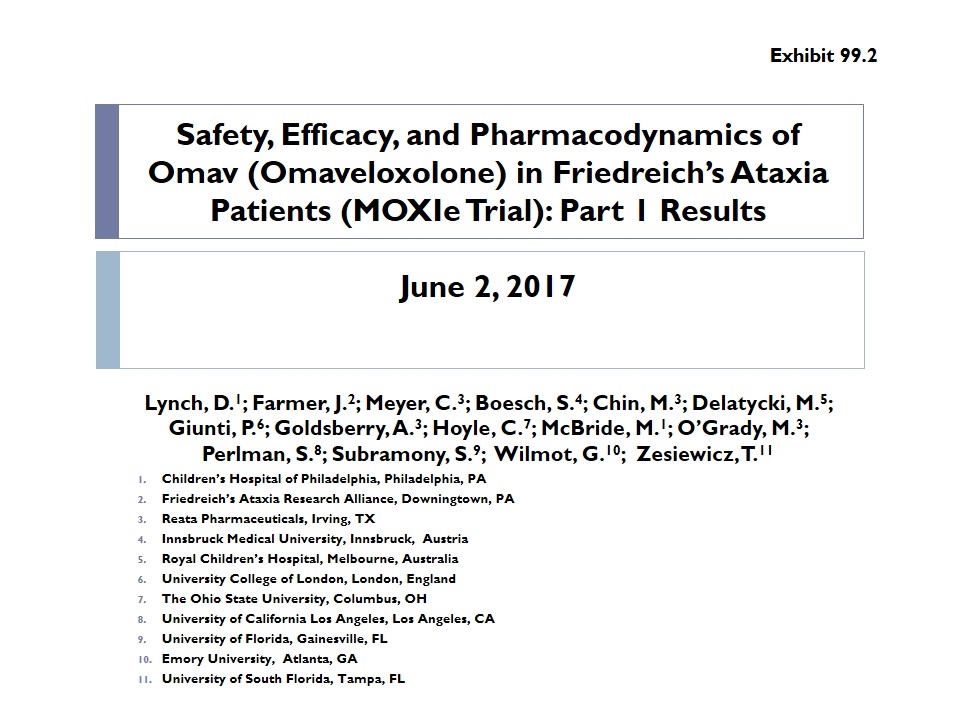
Safety, Efficacy, and Pharmacodynamics of Omav (Omaveloxolone) in Friedreich’s Ataxia Patients (MOXIe Trial): Part 1 Results June 2, 2017 Lynch, D.1; Farmer, J.2; Meyer, C.3; Boesch, S.4; Chin, M.3; Delatycki, M.5; Giunti, P.6; Goldsberry, A.3; Hoyle, C.7; McBride, M.1; O’Grady, M.3; Perlman, S.8; Subramony, S.9; Wilmot, G.10; Zesiewicz, T.11 Children’s Hospital of Philadelphia, Philadelphia, PA Friedreich’s Ataxia Research Alliance, Downingtown, PA Reata Pharmaceuticals, Irving, TX Innsbruck Medical University, Innsbruck, Austria Royal Children’s Hospital, Melbourne, Australia University College of London, London, England The Ohio State University, Columbus, OH University of California Los Angeles, Los Angeles, CA University of Florida, Gainesville, FL Emory University, Atlanta, GA University of South Florida, Tampa, FL Exhibit 99.2
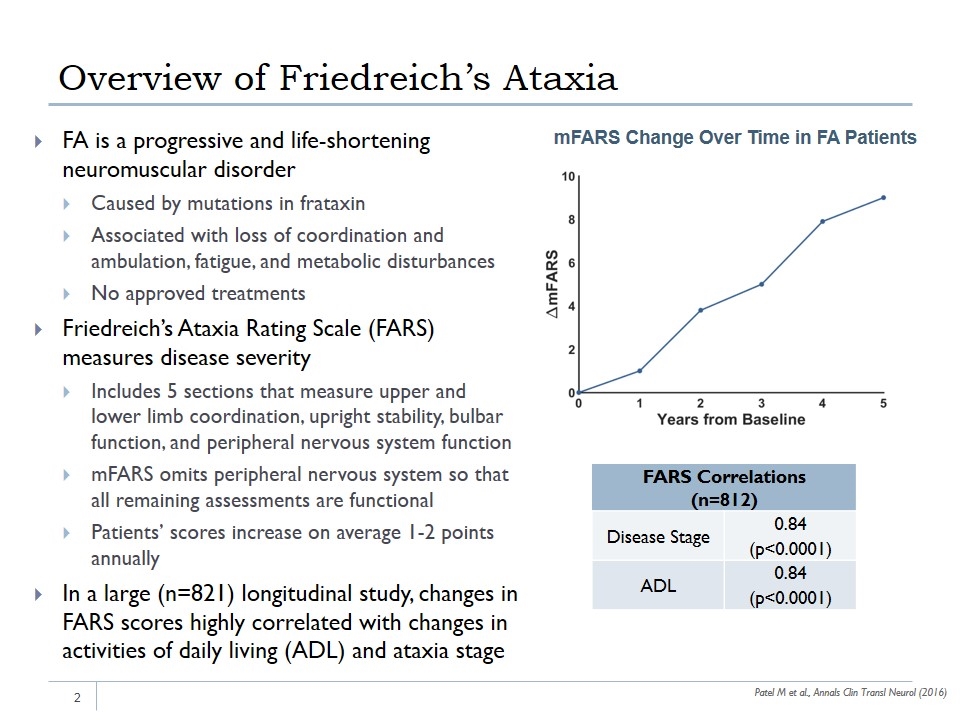
Overview of Friedreich’s Ataxia FA is a progressive and life-shortening neuromuscular disorder Caused by mutations in frataxin Associated with loss of coordination and ambulation, fatigue, and metabolic disturbances No approved treatments Friedreich’s Ataxia Rating Scale (FARS) measures disease severity Includes 5 sections that measure upper and lower limb coordination, upright stability, bulbar function, and peripheral nervous system function mFARS omits peripheral nervous system so that all remaining assessments are functional Patients’ scores increase on average 1-2 points annually In a large (n=821) longitudinal study, changes in FARS scores highly correlated with changes in activities of daily living (ADL) and ataxia stage Patel M et al., Annals Clin Transl Neurol (2016) mFARS Change Over Time in FA Patients FARS Correlations (n=812) Disease Stage 0.84 (p<0.0001) ADL 0.84 (p<0.0001)
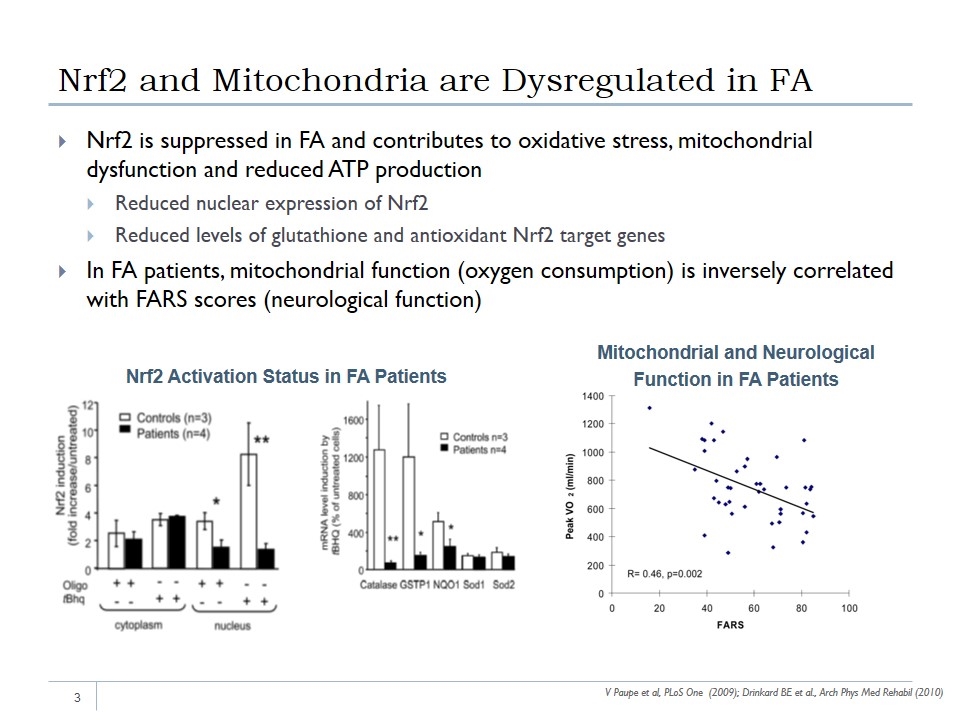
Nrf2 and Mitochondria are Dysregulated in FA Nrf2 is suppressed in FA and contributes to oxidative stress, mitochondrial dysfunction and reduced ATP production Reduced nuclear expression of Nrf2 Reduced levels of glutathione and antioxidant Nrf2 target genes In FA patients, mitochondrial function (oxygen consumption) is inversely correlated with FARS scores (neurological function) Nrf2 Activation Status in FA Patients Mitochondrial and Neurological Function in FA Patients V Paupe et al, PLoS One (2009); Drinkard BE et al., Arch Phys Med Rehabil (2010)
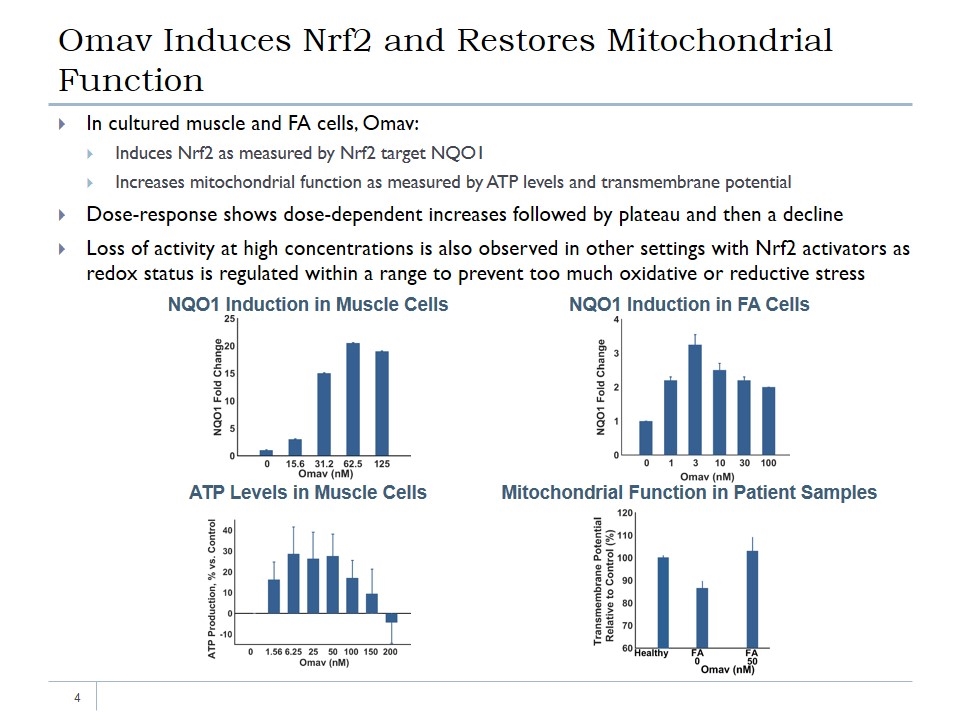
Omav Induces Nrf2 and Restores Mitochondrial Function In cultured muscle and FA cells, Omav: Induces Nrf2 as measured by Nrf2 target NQO1 Increases mitochondrial function as measured by ATP levels and transmembrane potential Dose-response shows dose-dependent increases followed by plateau and then a decline Loss of activity at high concentrations is also observed in other settings with Nrf2 activators as redox status is regulated within a range to prevent too much oxidative or reductive stress NQO1 Induction in Muscle Cells NQO1 Induction in FA Cells ATP Levels in Muscle Cells Mitochondrial Function in Patient Samples
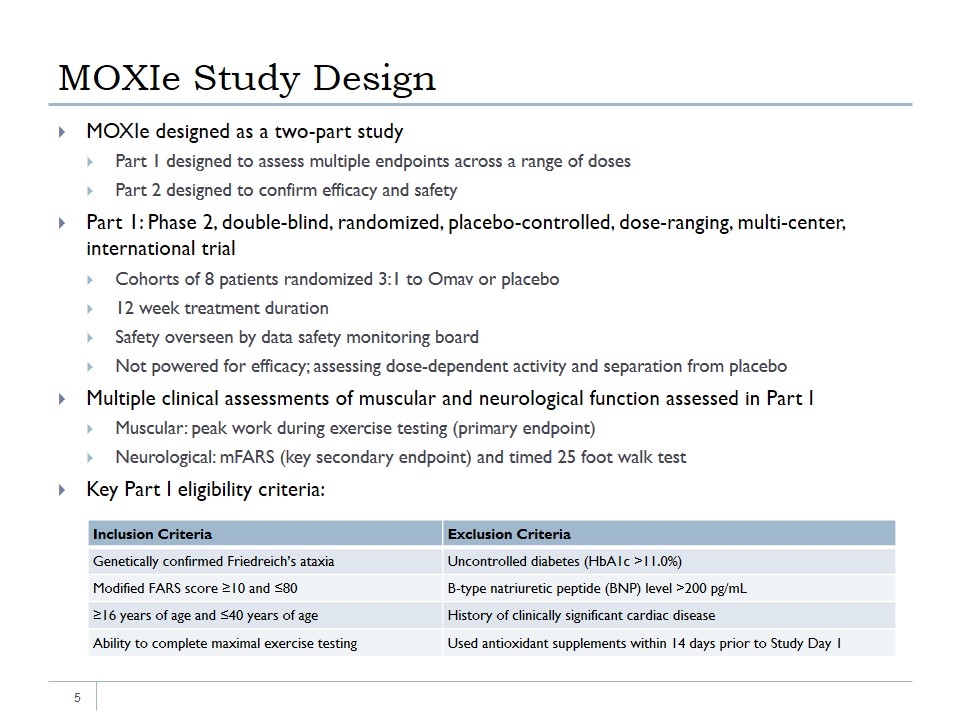
MOXIe Study Design MOXIe designed as a two-part study Part 1 designed to assess multiple endpoints across a range of doses Part 2 designed to confirm efficacy and safety Part 1: Phase 2, double-blind, randomized, placebo-controlled, dose-ranging, multi-center, international trial Cohorts of 8 patients randomized 3:1 to Omav or placebo 12 week treatment duration Safety overseen by data safety monitoring board Not powered for efficacy; assessing dose-dependent activity and separation from placebo Multiple clinical assessments of muscular and neurological function assessed in Part I Muscular: peak work during exercise testing (primary endpoint) Neurological: mFARS (key secondary endpoint) and timed 25 foot walk test Key Part I eligibility criteria: Inclusion Criteria Exclusion Criteria Genetically confirmed Friedreich’s ataxia Uncontrolled diabetes (HbA1c >11.0%) Modified FARS score ≥10 and ≤80 B-type natriuretic peptide (BNP) level >200 pg/mL ≥16 years of age and ≤40 years of age History of clinically significant cardiac disease Ability to complete maximal exercise testing Used antioxidant supplements within 14 days prior to Study Day 1
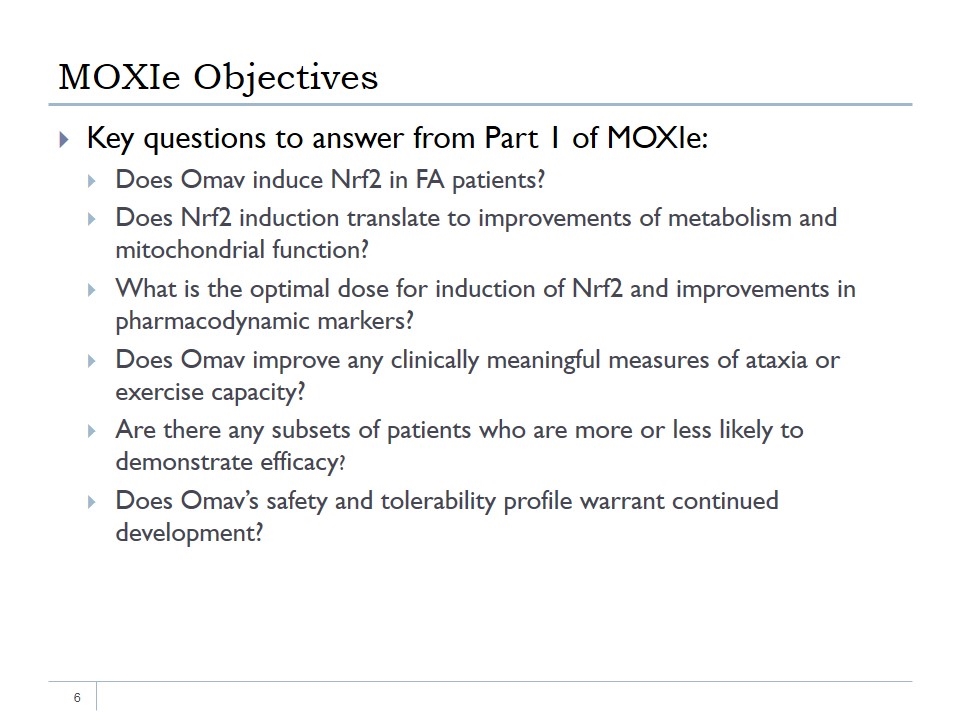
MOXIe Objectives Key questions to answer from Part 1 of MOXIe: Does Omav induce Nrf2 in FA patients? Does Nrf2 induction translate to improvements of metabolism and mitochondrial function? What is the optimal dose for induction of Nrf2 and improvements in pharmacodynamic markers? Does Omav improve any clinically meaningful measures of ataxia or exercise capacity? Are there any subsets of patients who are more or less likely to demonstrate efficacy? Does Omav’s safety and tolerability profile warrant continued development?
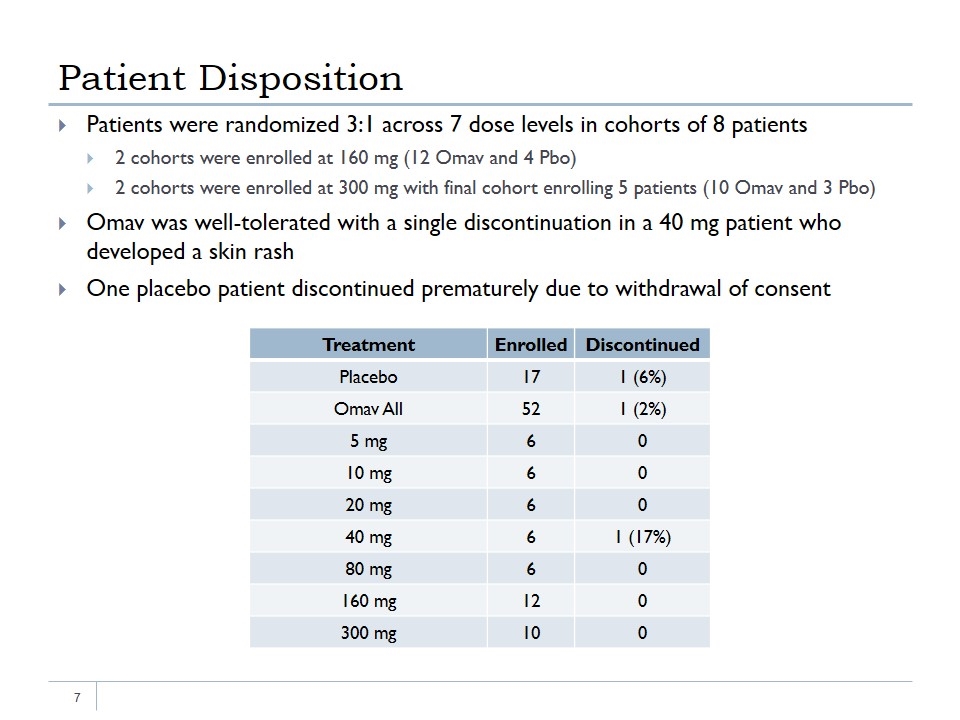
Patient Disposition Patients were randomized 3:1 across 7 dose levels in cohorts of 8 patients 2 cohorts were enrolled at 160 mg (12 Omav and 4 Pbo) 2 cohorts were enrolled at 300 mg with final cohort enrolling 5 patients (10 Omav and 3 Pbo) Omav was well-tolerated with a single discontinuation in a 40 mg patient who developed a skin rash One placebo patient discontinued prematurely due to withdrawal of consent Treatment Enrolled Discontinued Placebo 17 1 (6%) Omav All 52 1 (2%) 5 mg 6 0 10 mg 6 0 20 mg 6 0 40 mg 6 1 (17%) 80 mg 6 0 160 mg 12 0 300 mg 10 0
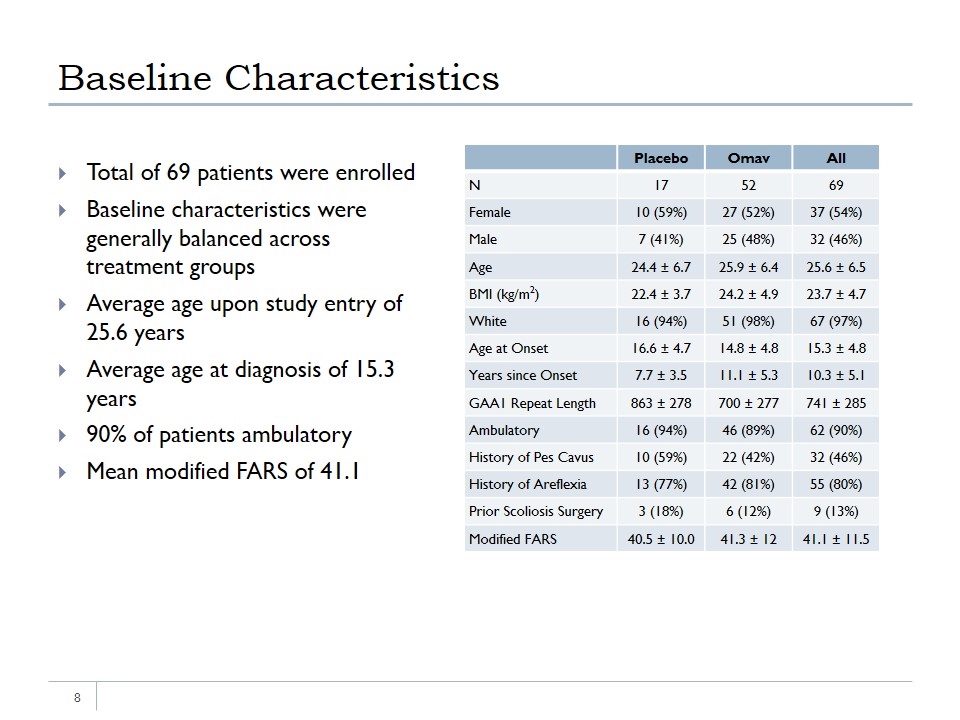
Baseline Characteristics Total of 69 patients were enrolled Baseline characteristics were generally balanced across treatment groups Average age upon study entry of 25.6 years Average age at diagnosis of 15.3 years 90% of patients ambulatory Mean modified FARS of 41.1 Placebo Omav All N 17 52 69 Female 10 (59%) 27 (52%) 37 (54%) Male 7 (41%) 25 (48%) 32 (46%) Age 24.4 ± 6.7 25.9 ± 6.4 25.6 ± 6.5 BMI (kg/m2) 22.4 ± 3.7 24.2 ± 4.9 23.7 ± 4.7 White 16 (94%) 51 (98%) 67 (97%) Age at Onset 16.6 ± 4.7 14.8 ± 4.8 15.3 ± 4.8 Years since Onset 7.7 ± 3.5 11.1 ± 5.3 10.3 ± 5.1 GAA1 Repeat Length 863 ± 278 700 ± 277 741 ± 285 Ambulatory 16 (94%) 46 (89%) 62 (90%) History of Pes Cavus 10 (59%) 22 (42%) 32 (46%) History of Areflexia 13 (77%) 42 (81%) 55 (80%) Prior Scoliosis Surgery 3 (18%) 6 (12%) 9 (13%) Modified FARS 40.5 ± 10.0 41.3 ± 12 41.1 ± 11.5
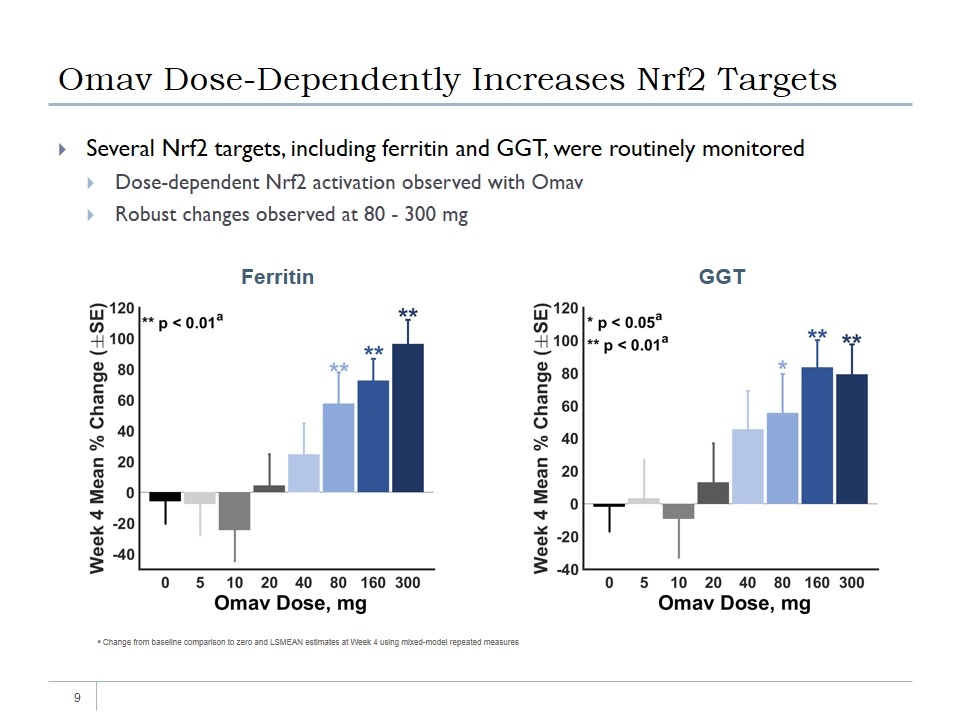
Omav Dose-Dependently Increases Nrf2 Targets Several Nrf2 targets, including ferritin and GGT, were routinely monitored Dose-dependent Nrf2 activation observed with Omav Robust changes observed at 80 - 300 mg Ferritin GGT a Change from baseline comparison to zero and LSMEAN estimates at Week 4 using mixed-model repeated measures
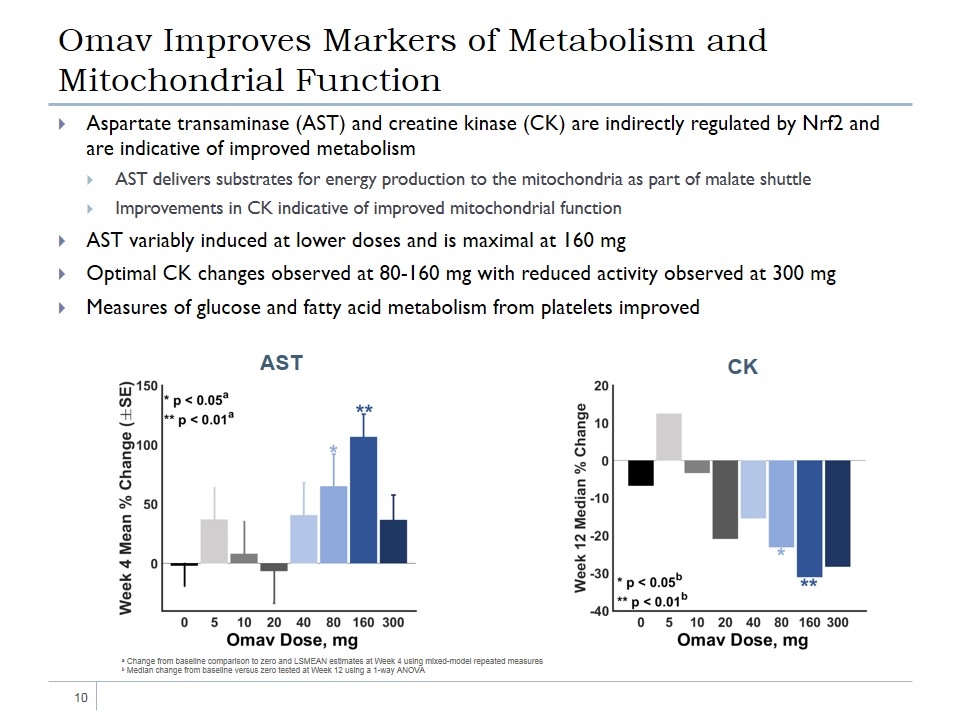
Omav Improves Markers of Metabolism and Mitochondrial Function Aspartate transaminase (AST) and creatine kinase (CK) are indirectly regulated by Nrf2 and are indicative of improved metabolism AST delivers substrates for energy production to the mitochondria as part of malate shuttle Improvements in CK indicative of improved mitochondrial function AST variably induced at lower doses and is maximal at 160 mg Optimal CK changes observed at 80-160 mg with reduced activity observed at 300 mg Measures of glucose and fatty acid metabolism from platelets improved AST CK a Change from baseline comparison to zero and LSMEAN estimates at Week 4 using mixed-model repeated measures b Median change from baseline versus zero tested at Week 12 using a 1-way ANOVA
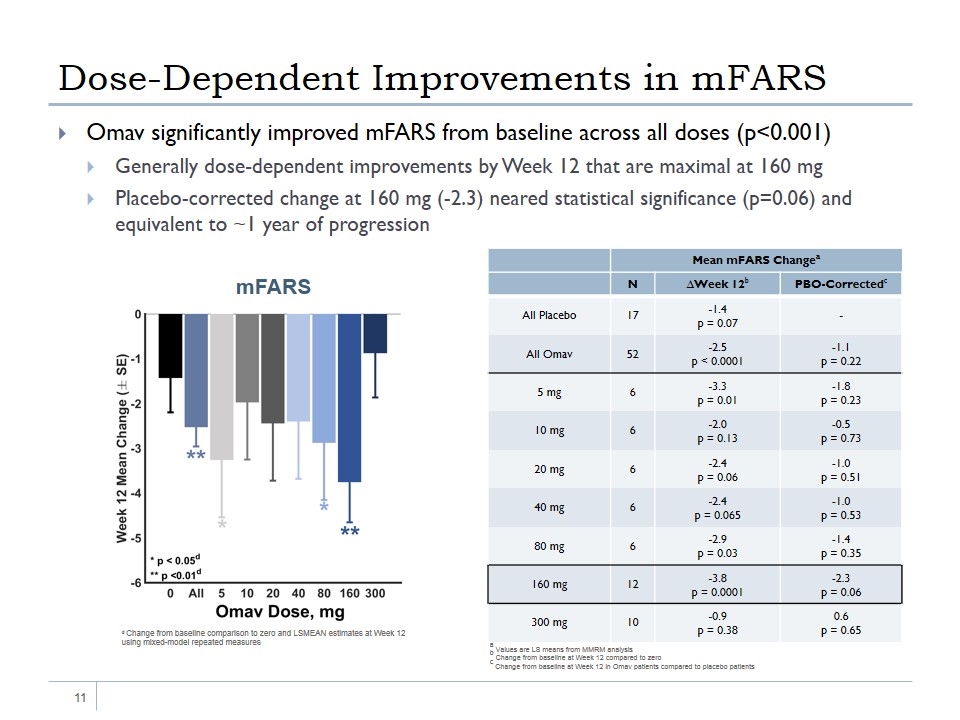
Dose-Dependent Improvements in mFARS Omav significantly improved mFARS from baseline across all doses (p<0.001) Generally dose-dependent improvements by Week 12 that are maximal at 160 mg Placebo-corrected change at 160 mg (-2.3) neared statistical significance (p=0.06) and equivalent to ~1 year of progression mFARS Mean mFARS Changea N ∆Week 12b PBO-Correctedc All Placebo 17 -1.4 p = 0.07 - All Omav 52 -2.5 p < 0.0001 -1.1 p = 0.22 5 mg 6 -3.3 p = 0.01 -1.8 p = 0.23 10 mg 6 -2.0 p = 0.13 -0.5 p = 0.73 20 mg 6 -2.4 p = 0.06 -1.0 p = 0.51 40 mg 6 -2.4 p = 0.065 -1.0 p = 0.53 80 mg 6 -2.9 p = 0.03 -1.4 p = 0.35 160 mg 12 -3.8 p = 0.0001 -2.3 p = 0.06 300 mg 10 -0.9 p = 0.38 0.6 p = 0.65 a Values are LS means from MMRM analysis b Change from baseline at Week 12 compared to zero c Change from baseline at Week 12 in Omav patients compared to placebo patients d Change from baseline comparison to zero and LSMEAN estimates at Week 12 using mixed-model repeated measures
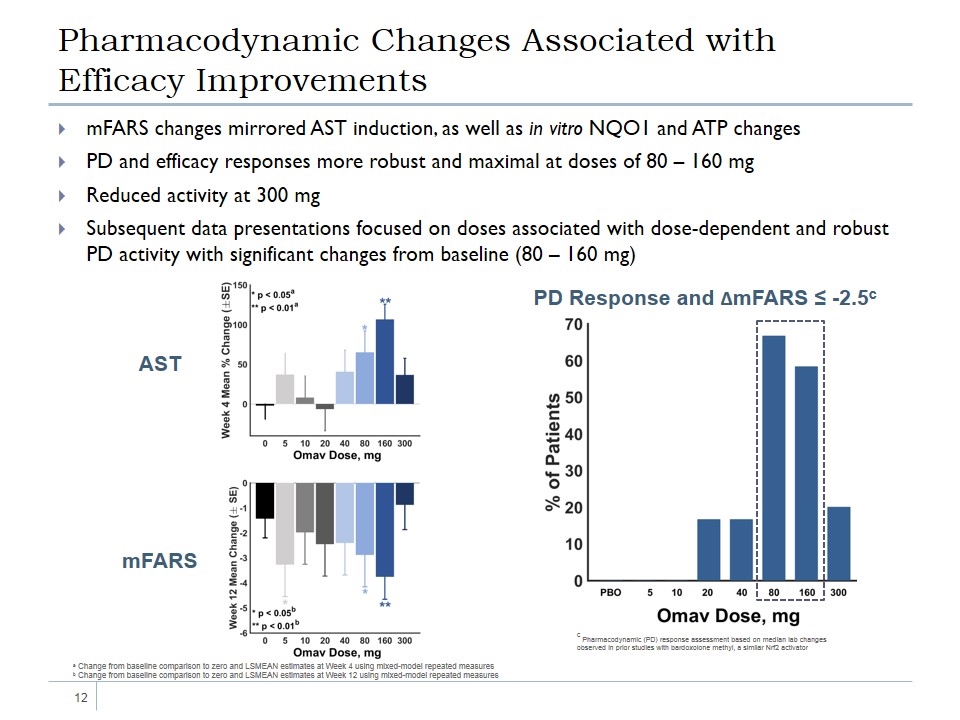
Pharmacodynamic Changes Associated with Efficacy Improvements mFARS changes mirrored AST induction, as well as in vitro NQO1 and ATP changes PD and efficacy responses more robust and maximal at doses of 80 – 160 mg Reduced activity at 300 mg Subsequent data presentations focused on doses associated with dose-dependent and robust PD activity with significant changes from baseline (80 – 160 mg) PD Response and ΔmFARS ≤ -2.5c AST mFARS c Pharmacodynamic (PD) response assessment based on median lab changes observed in prior studies with bardoxolone methyl, a similar Nrf2 activator a Change from baseline comparison to zero and LSMEAN estimates at Week 4 using mixed-model repeated measures b Change from baseline comparison to zero and LSMEAN estimates at Week 12 using mixed-model repeated measures
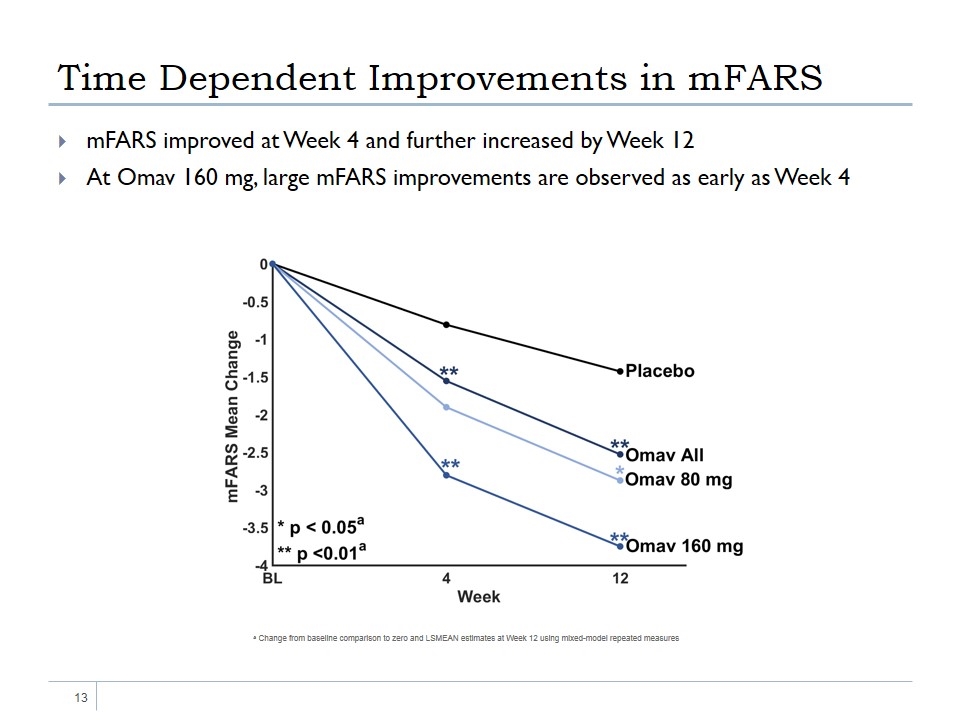
Time Dependent Improvements in mFARS mFARS improved at Week 4 and further increased by Week 12 At Omav 160 mg, large mFARS improvements are observed as early as Week 4 a Change from baseline comparison to zero and LSMEAN estimates at Week 12 using mixed-model repeated measures
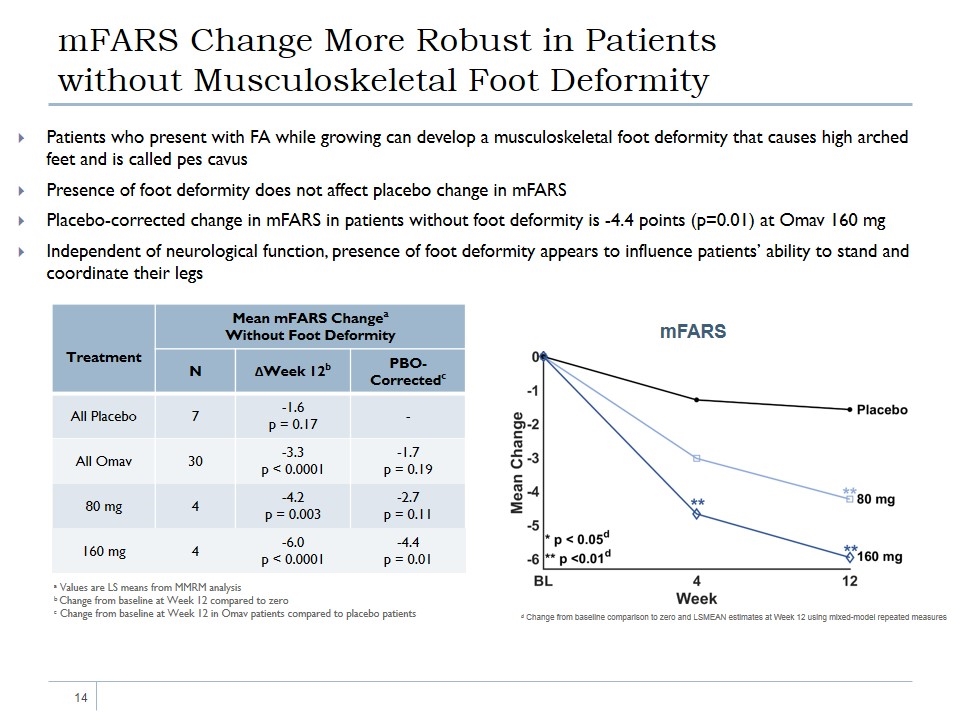
mFARS Change More Robust in Patients without Musculoskeletal Foot Deformity Patients who present with FA while growing can develop a musculoskeletal foot deformity that causes high arched feet and is called pes cavus Presence of foot deformity does not affect placebo change in mFARS Placebo-corrected change in mFARS in patients without foot deformity is -4.4 points (p=0.01) at Omav 160 mg Independent of neurological function, presence of foot deformity appears to influence patients’ ability to stand and coordinate their legs Treatment Mean mFARS Changea Without Foot Deformity N ∆Week 12b PBO-Correctedc All Placebo 7 -1.6 p = 0.17 - All Omav 30 -3.3 p < 0.0001 -1.7 p = 0.19 80 mg 4 -4.2 p = 0.003 -2.7 p = 0.11 160 mg 4 -6.0 p < 0.0001 -4.4 p = 0.01 mFARS a Values are LS means from MMRM analysis b Change from baseline at Week 12 compared to zero c Change from baseline at Week 12 in Omav patients compared to placebo patients d Change from baseline comparison to zero and LSMEAN estimates at Week 12 using mixed-model repeated measures
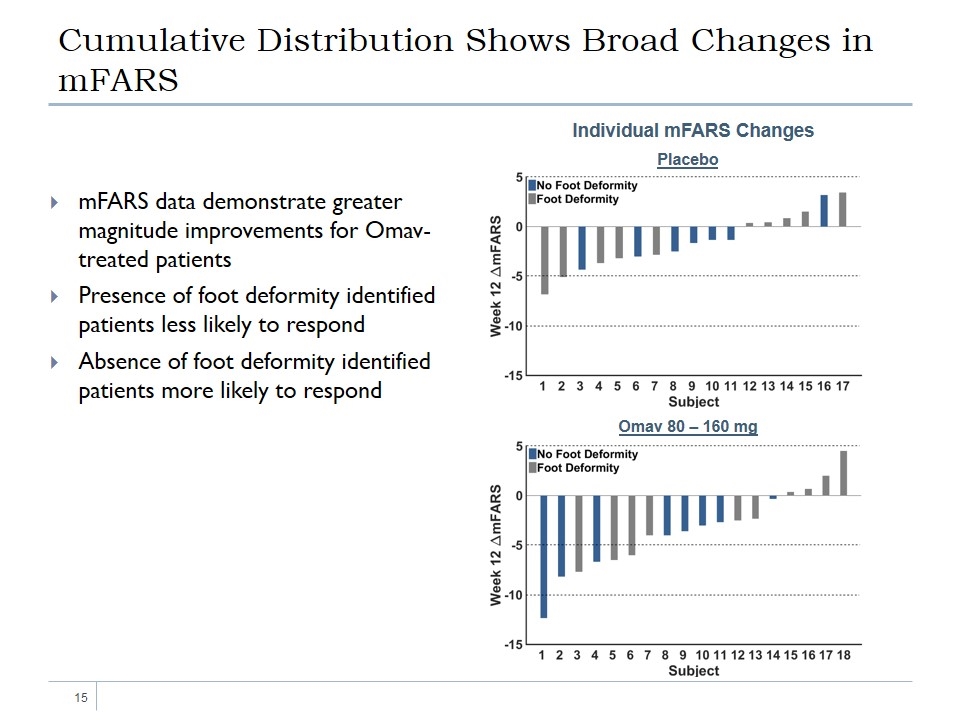
Cumulative Distribution Shows Broad Changes in mFARS mFARS data demonstrate greater magnitude improvements for Omav-treated patients Presence of foot deformity identified patients less likely to respond Absence of foot deformity identified patients more likely to respond Omav 80 – 160 mg Individual mFARS Changes Placebo
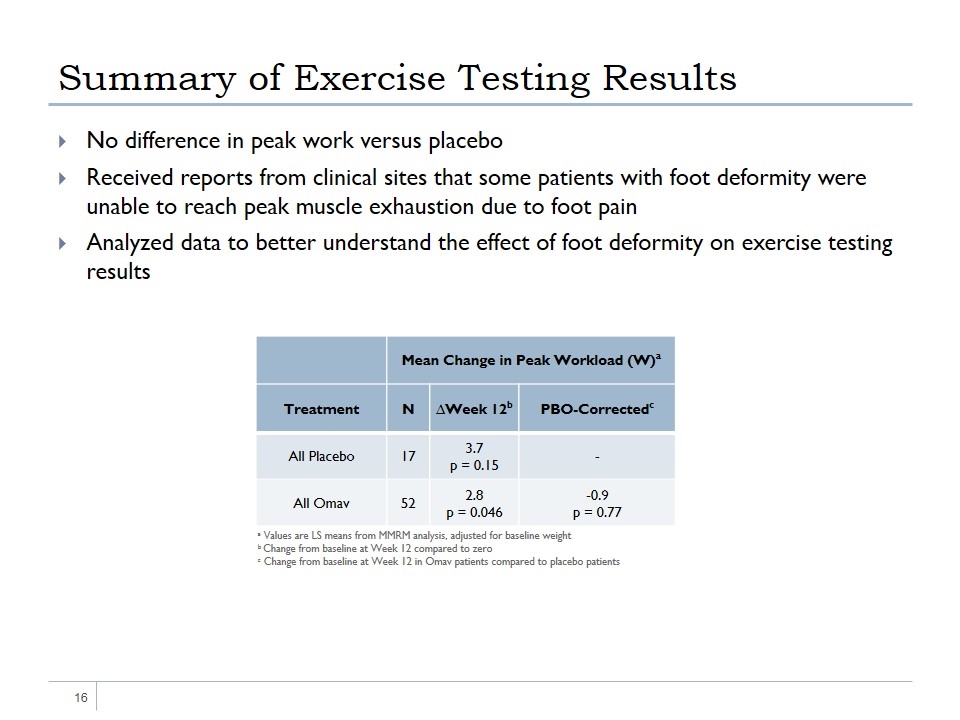
Summary of Exercise Testing Results No difference in peak work versus placebo Received reports from clinical sites that some patients with foot deformity were unable to reach peak muscle exhaustion due to foot pain Analyzed data to better understand the effect of foot deformity on exercise testing results Mean Change in Peak Workload (W)a Treatment N ∆Week 12b PBO-Correctedc All Placebo 17 3.7 p = 0.15 - All Omav 52 2.8 p = 0.046 -0.9 p = 0.77 a Values are LS means from MMRM analysis, adjusted for baseline weight b Change from baseline at Week 12 compared to zero c Change from baseline at Week 12 in Omav patients compared to placebo patients
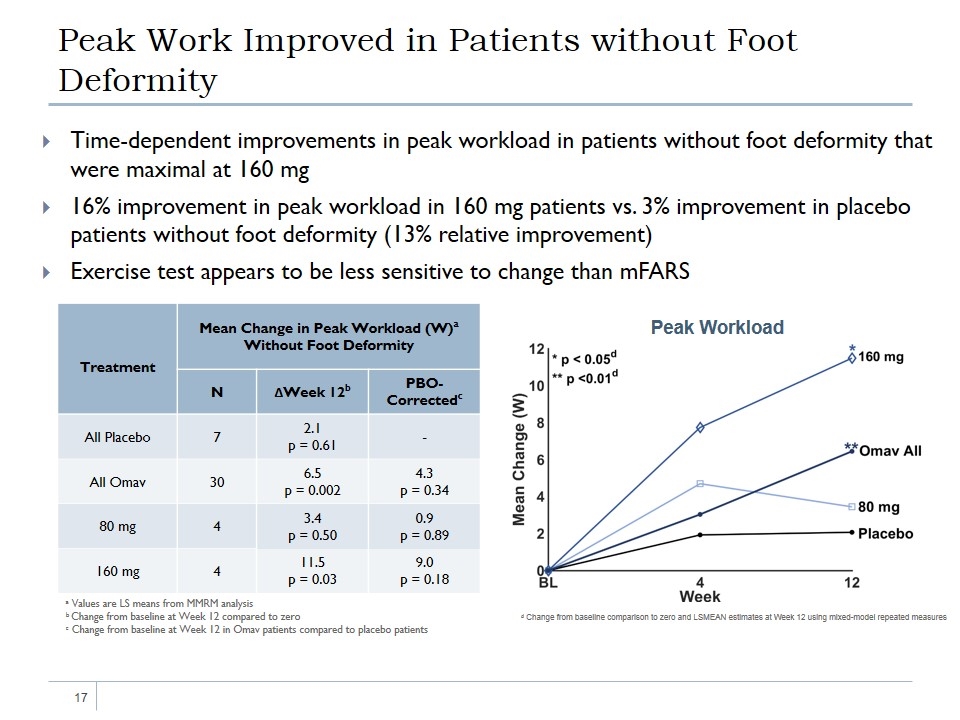
Peak Work Improved in Patients without Foot Deformity Time-dependent improvements in peak workload in patients without foot deformity that were maximal at 160 mg 16% improvement in peak workload in 160 mg patients vs. 3% improvement in placebo patients without foot deformity (13% relative improvement) Exercise test appears to be less sensitive to change than mFARS Treatment Mean Change in Peak Workload (W)a Without Foot Deformity N ΔWeek 12b PBO-Correctedc All Placebo 7 2.1 p = 0.61 - All Omav 30 6.5 p = 0.002 4.3 p = 0.34 80 mg 4 3.4 p = 0.50 0.9 p = 0.89 160 mg 4 11.5 p = 0.03 9.0 p = 0.18 Peak Workload a Values are LS means from MMRM analysis b Change from baseline at Week 12 compared to zero c Change from baseline at Week 12 in Omav patients compared to placebo patients d Change from baseline comparison to zero and LSMEAN estimates at Week 12 using mixed-model repeated measures
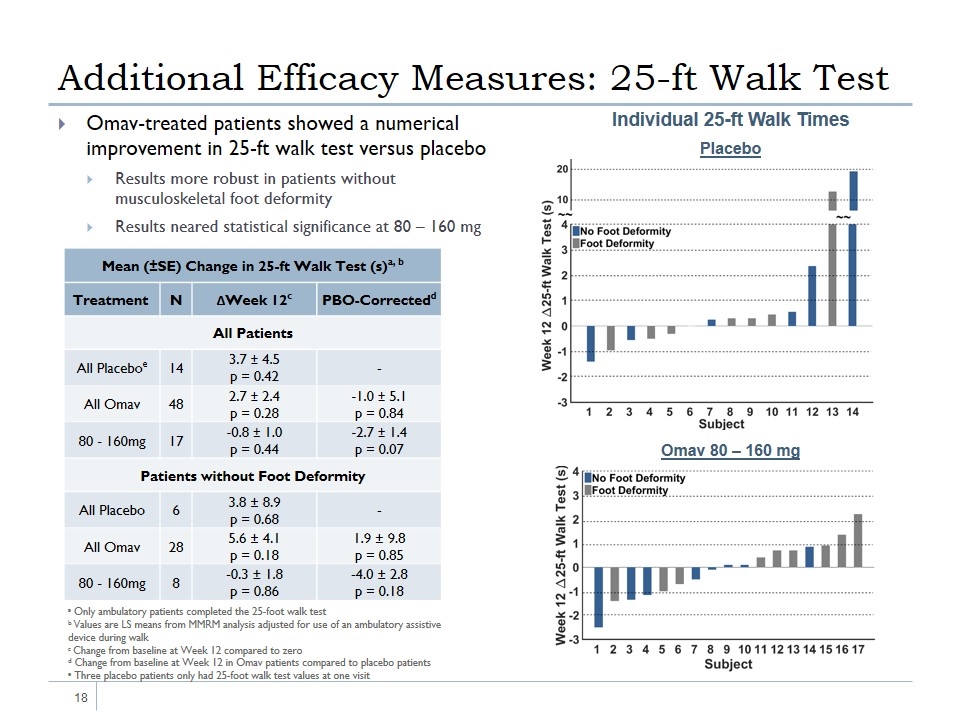
Additional Efficacy Measures: 25-ft Walk Test Omav-treated patients showed a numerical improvement in 25-ft walk test versus placebo Results more robust in patients without musculoskeletal foot deformity Results neared statistical significance at 80 – 160 mg Omav 80 – 160 mg Individual 25-ft Walk Times Mean (±SE) Change in 25-ft Walk Test (s)a, b Treatment N ΔWeek 12c PBO-Correctedd All Patients All Placeboe 14 3.7 ± 4.5 p = 0.42 - All Omav 48 2.7 ± 2.4 p = 0.28 -1.0 ± 5.1 p = 0.84 80 - 160mg 17 -0.8 ± 1.0 p = 0.44 -2.7 ± 1.4 p = 0.07 Patients without Foot Deformity All Placebo 6 3.8 ± 8.9 p = 0.68 - All Omav 28 5.6 ± 4.1 p = 0.18 1.9 ± 9.8 p = 0.85 80 - 160mg 8 -0.3 ± 1.8 p = 0.86 -4.0 ± 2.8 p = 0.18 Placebo a Only ambulatory patients completed the 25-foot walk test b Values are LS means from MMRM analysis adjusted for use of an ambulatory assistive device during walk c Change from baseline at Week 12 compared to zero d Change from baseline at Week 12 in Omav patients compared to placebo patients e Three placebo patients only had 25-foot walk test values at one visit
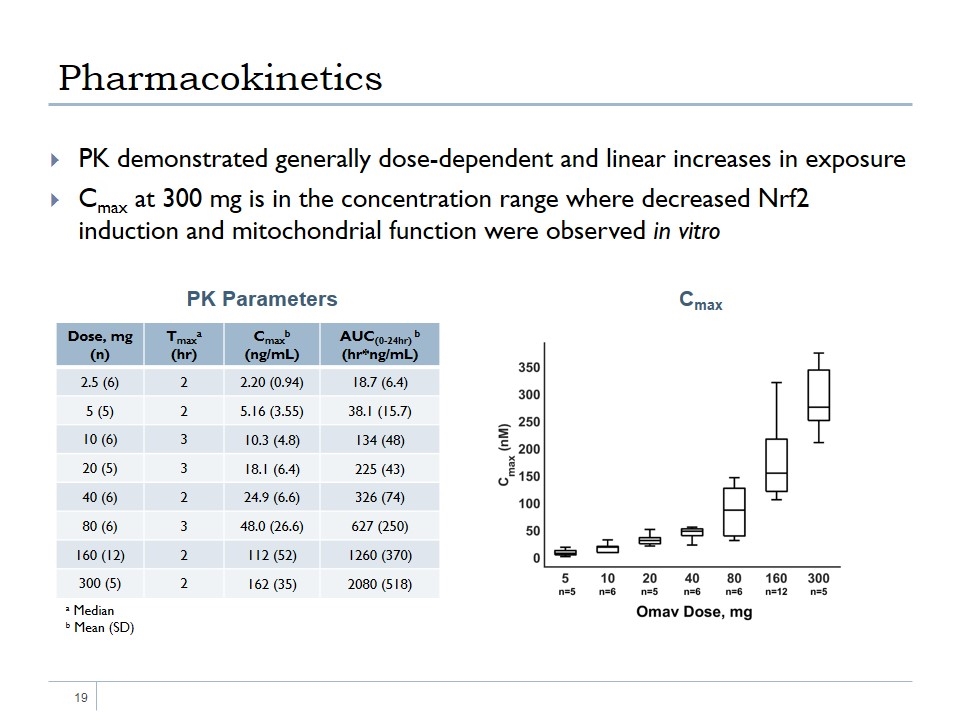
Pharmacokinetics PK demonstrated generally dose-dependent and linear increases in exposure Cmax at 300 mg is in the concentration range where decreased Nrf2 induction and mitochondrial function were observed in vitro Cmax Dose, mg (n) Tmaxa (hr) Cmaxb (ng/mL) AUC(0-24hr) b (hr*ng/mL) 2.5 (6) 2 2.20 (0.94) 18.7 (6.4) 5 (5) 2 5.16 (3.55) 38.1 (15.7) 10 (6) 3 10.3 (4.8) 134 (48) 20 (5) 3 18.1 (6.4) 225 (43) 40 (6) 2 24.9 (6.6) 326 (74) 80 (6) 3 48.0 (26.6) 627 (250) 160 (12) 2 112 (52) 1260 (370) 300 (5) 2 162 (35) 2080 (518) a Median b Mean (SD) PK Parameters
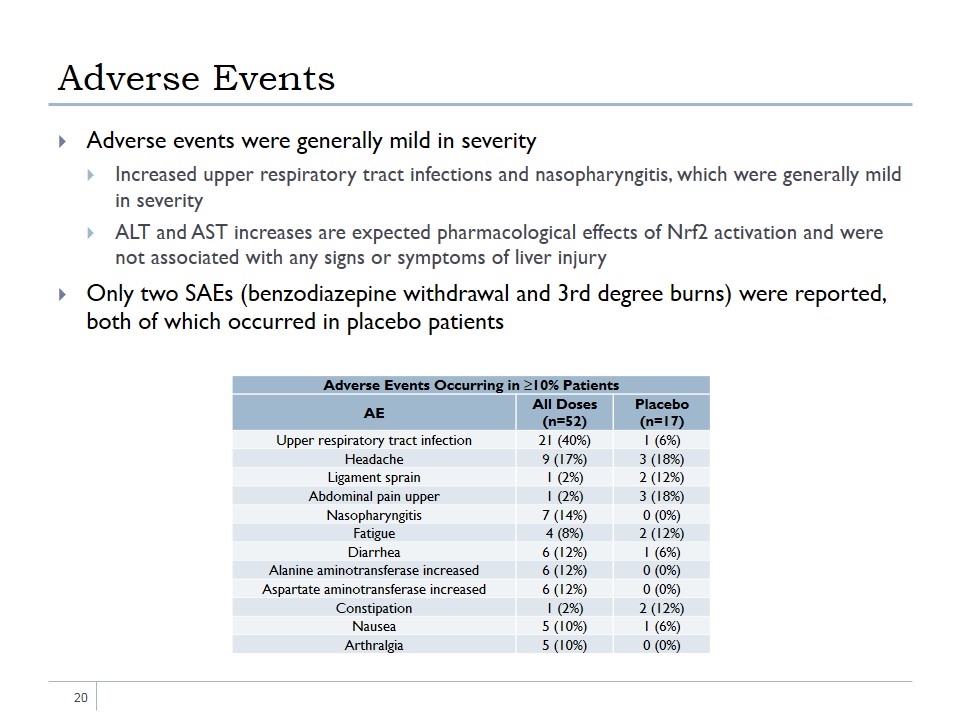
Adverse Events Adverse events were generally mild in severity Increased upper respiratory tract infections and nasopharyngitis, which were generally mild in severity ALT and AST increases are expected pharmacological effects of Nrf2 activation and were not associated with any signs or symptoms of liver injury Only two SAEs (benzodiazepine withdrawal and 3rd degree burns) were reported, both of which occurred in placebo patients Adverse Events Occurring in ≥10% Patients AE All Doses (n=52) Placebo (n=17) Upper respiratory tract infection 21 (40%) 1 (6%) Headache 9 (17%) 3 (18%) Ligament sprain 1 (2%) 2 (12%) Abdominal pain upper 1 (2%) 3 (18%) Nasopharyngitis 7 (14%) 0 (0%) Fatigue 4 (8%) 2 (12%) Diarrhea 6 (12%) 1 (6%) Alanine aminotransferase increased 6 (12%) 0 (0%) Aspartate aminotransferase increased 6 (12%) 0 (0%) Constipation 1 (2%) 2 (12%) Nausea 5 (10%) 1 (6%) Arthralgia 5 (10%) 0 (0%)
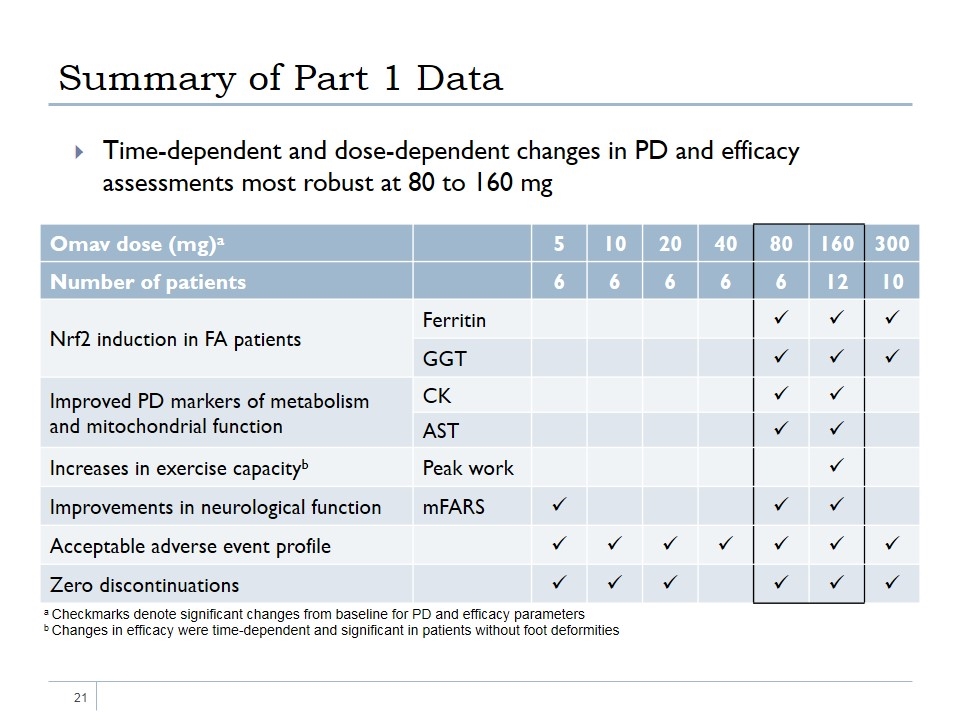
Summary of Part 1 Data Time-dependent and dose-dependent changes in PD and efficacy assessments most robust at 80 to 160 mg Omav dose (mg)a 5 10 20 40 80 160 300 Number of patients 6 6 6 6 6 12 10 Nrf2 induction in FA patients Ferritin ü ü ü GGT ü ü ü Improved PD markers of metabolism and mitochondrial function CK ü ü AST ü ü Increases in exercise capacityb Peak work ü Improvements in neurological function mFARS ü ü ü Acceptable adverse event profile ü ü ü ü ü ü ü Zero discontinuations ü ü ü ü ü ü a Checkmarks denote significant changes from baseline for PD and efficacy parameters b Changes in efficacy were time-dependent and significant in patients without foot deformities
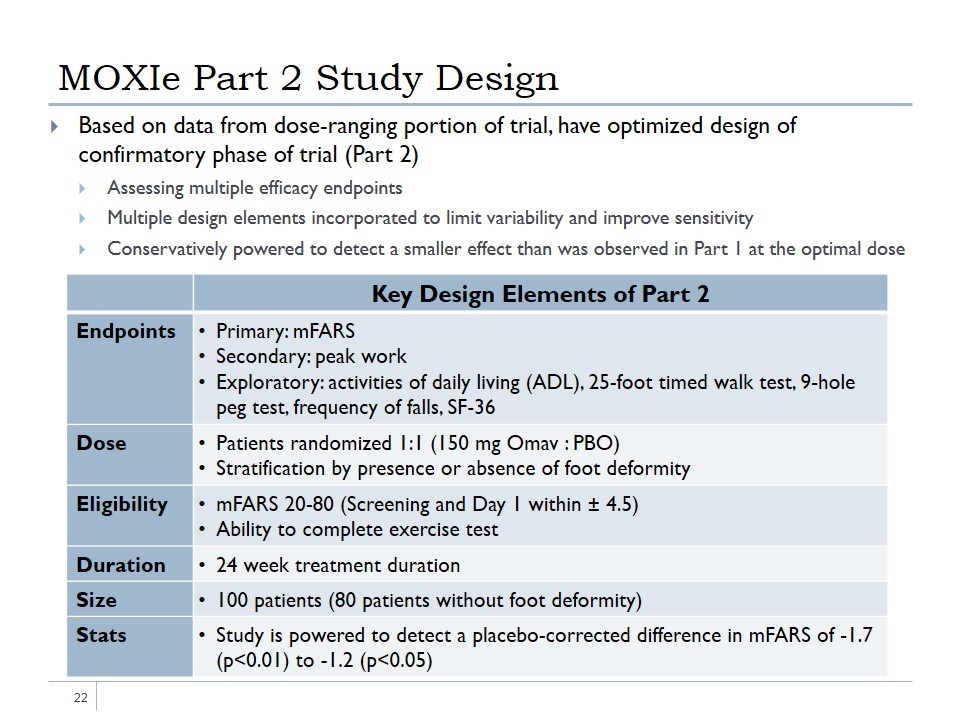
MOXIe Part 2 Study Design Key Design Elements of Part 2 Endpoints Primary: mFARS Secondary: peak work Exploratory: activities of daily living (ADL), 25-foot timed walk test, 9-hole peg test, frequency of falls, SF-36 Dose Patients randomized 1:1 (150 mg Omav : PBO) Stratification by presence or absence of foot deformity Eligibility mFARS 20-80 (Screening and Day 1 within ± 4.5) Ability to complete exercise test Duration 24 week treatment duration Size 100 patients (80 patients without foot deformity) Stats Study is powered to detect a placebo-corrected difference in mFARS of -1.7 (p<0.01) to -1.2 (p<0.05) Based on data from dose-ranging portion of trial, have optimized design of confirmatory phase of trial (Part 2) Assessing multiple efficacy endpoints Multiple design elements incorporated to limit variability and improve sensitivity Conservatively powered to detect a smaller effect than was observed in Part 1 at the optimal dose

Thanks to all investigators, site personnel, data safety monitoring committee members, FARA and patients who participated in the design, conduct, and analysis of MOXIe






















